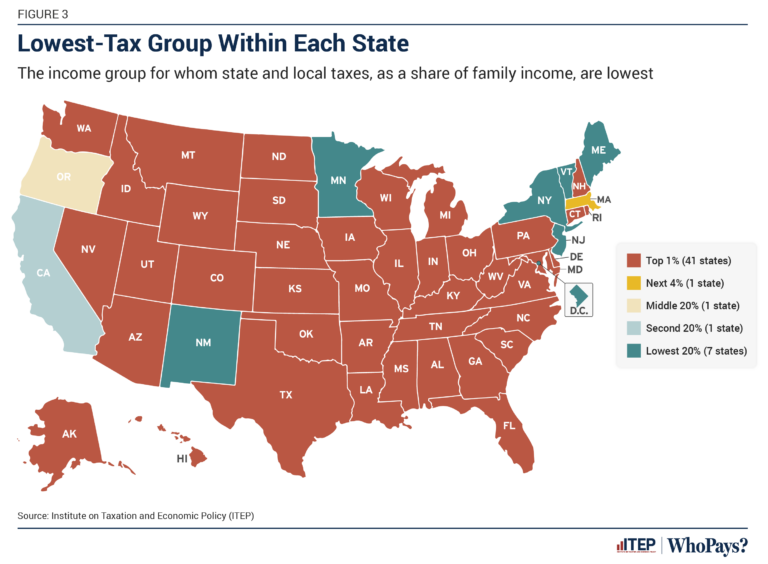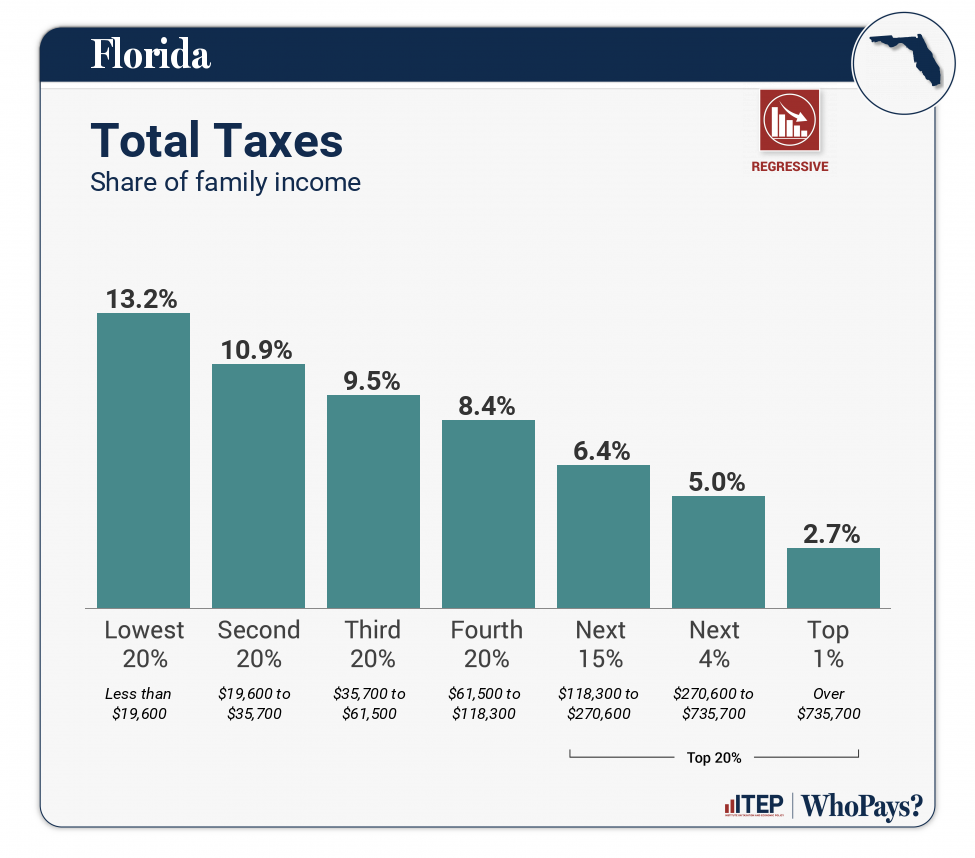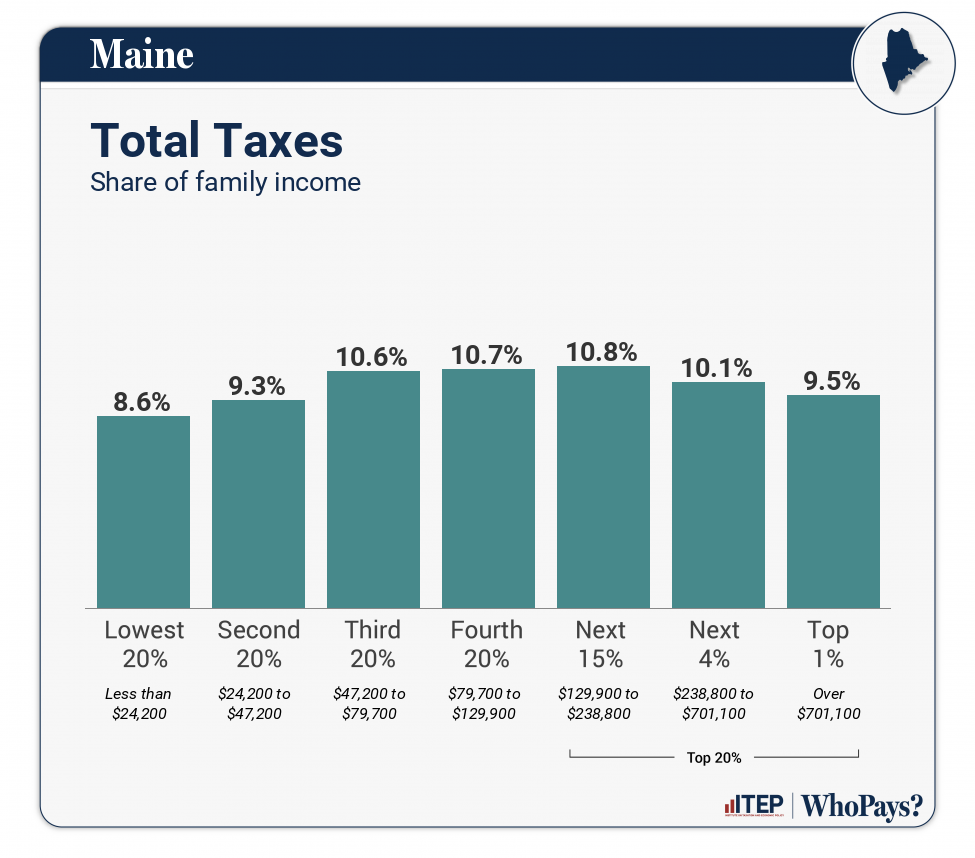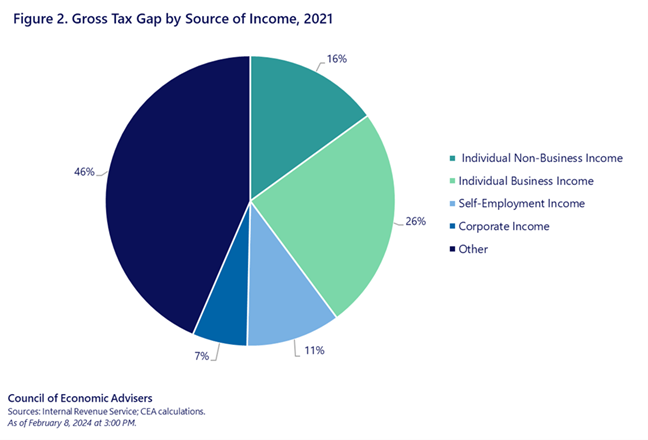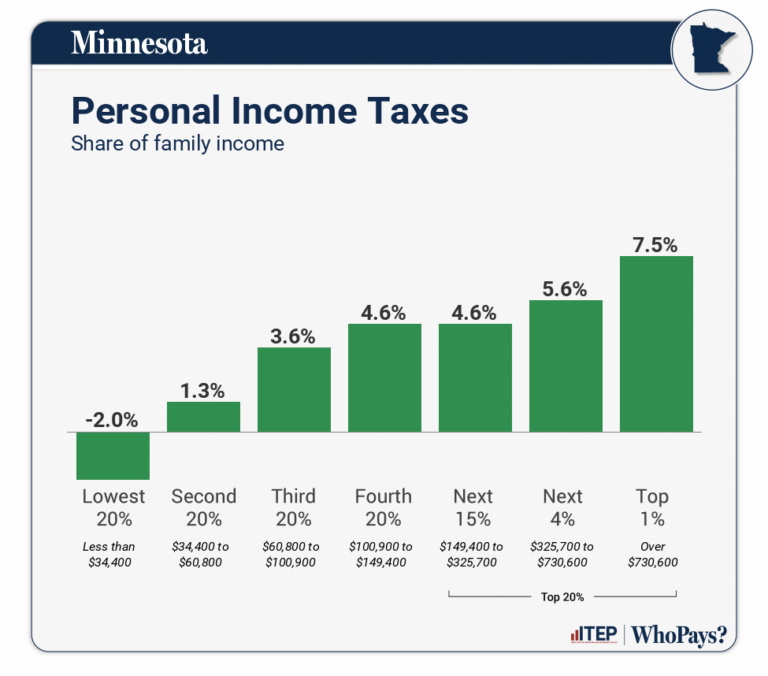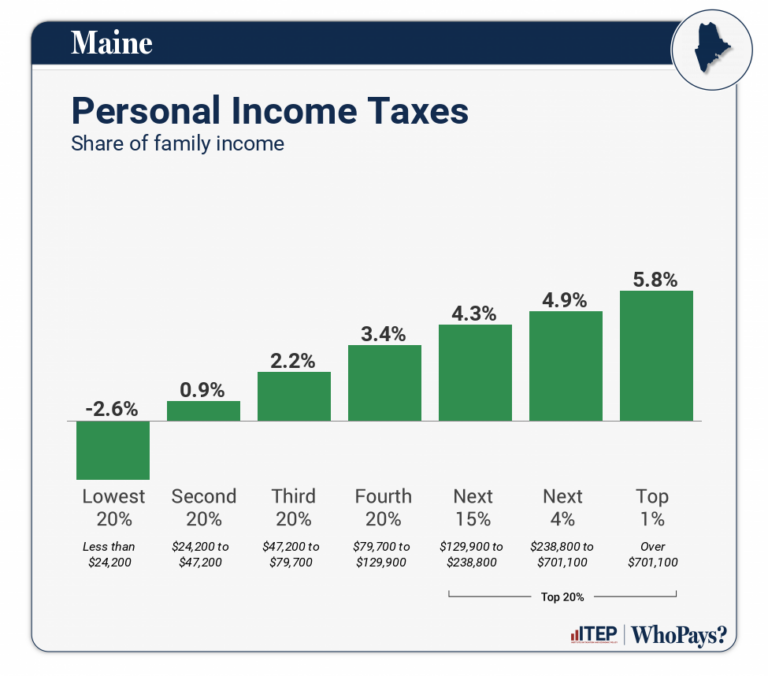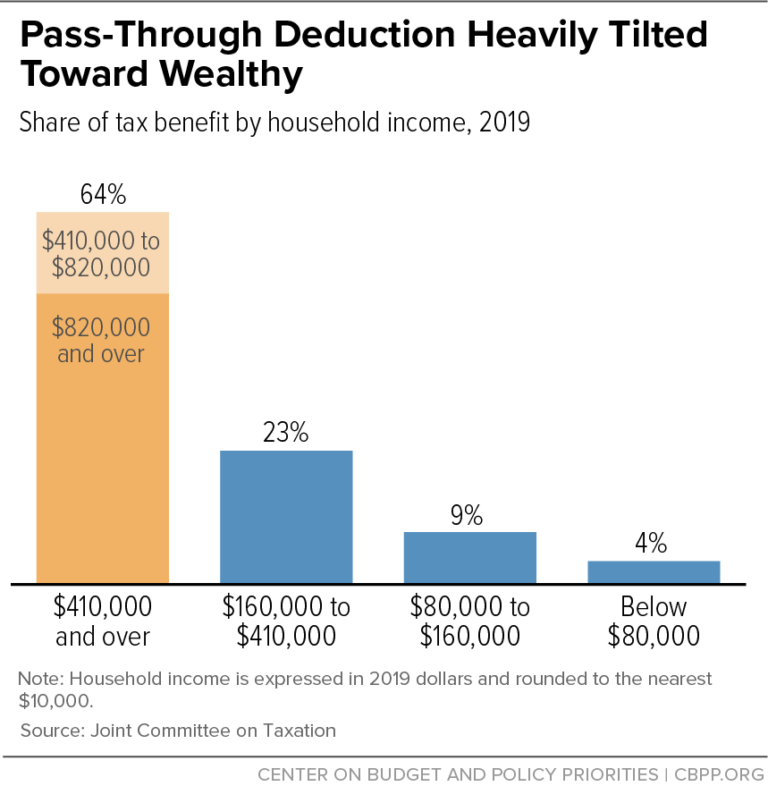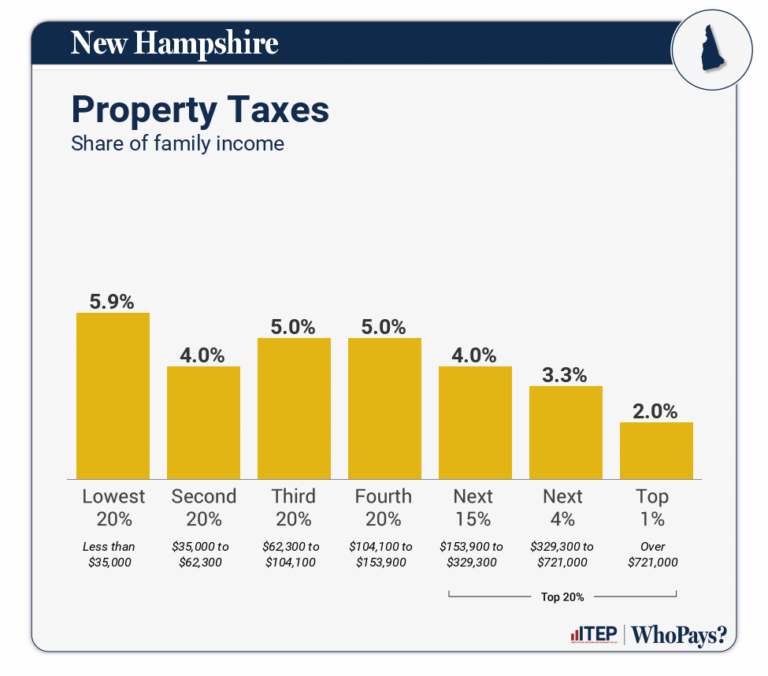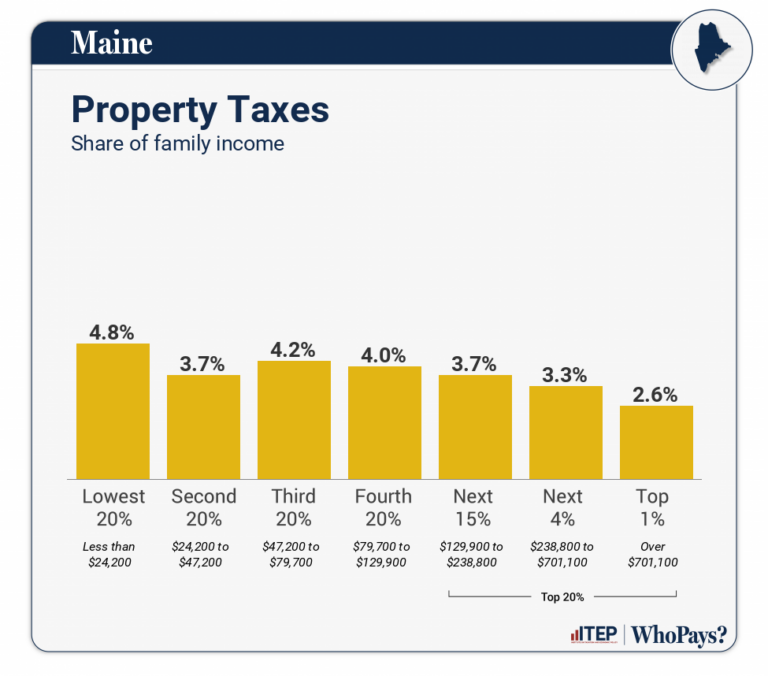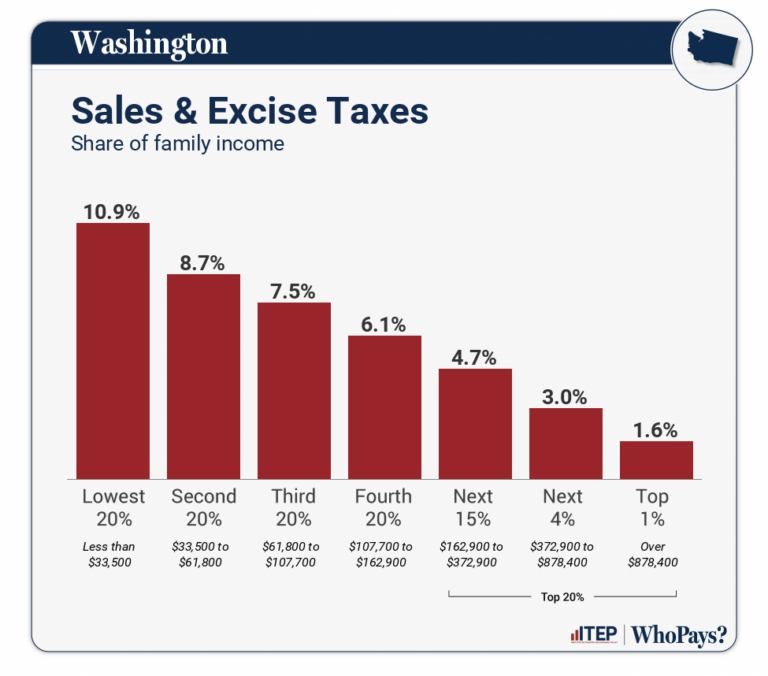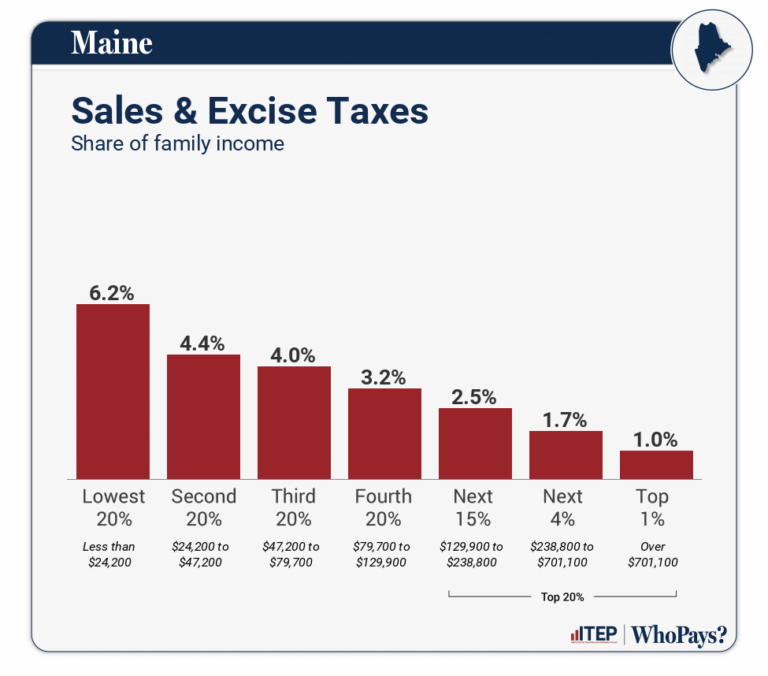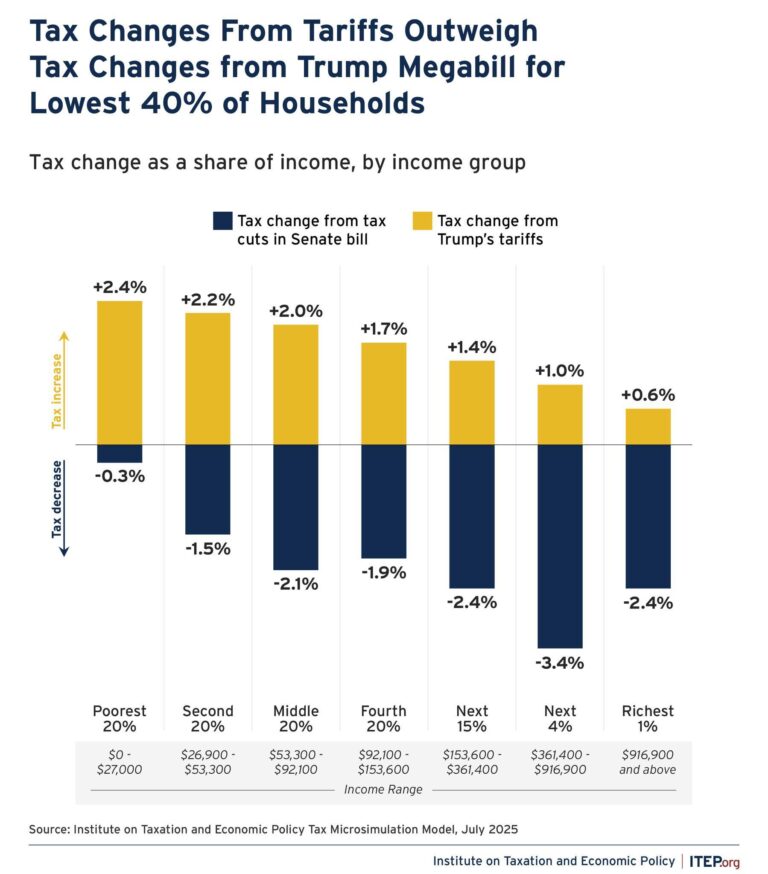What is tax fairness?
Taxes help pay for things that benefit everyone, like good schools, clean air and water, and safe roads. Businesses also need these things to succeed, along with a healthy, housed, and educated workforce, modern infrastructure, and affordable energy. Fair taxes mean everyone pitches in according to their means, so those who have less pay less, and those who have more pay more. Unfortunately, the vast majority of states still have upside-down tax structures, meaning that families with wealth pay a smaller portion of their income in taxes than families with low income. That’s not fair.
Most public services are funded by a mix of income, property, and consumption taxes. Some states eliminate income taxes altogether. But when they do, they often raise other taxes and reduce support for essential services and infrastructure. This hurts people with low income the most and worsens economic and racial inequality. Ultimately, the “no income tax” approach means low- and middle-income households end up paying a greater share of their income towards shared services and infrastructure than wealthy people — but they get less of the benefit. That’s not fair either.
Why is tax fairness important?
- Unfair tax structures worsen income inequality. State-by-state analysis from the Institute on Taxation and Economic Policy (ITEP) shows that on average, the least wealthy 20% of taxpayers pay state and local tax rates that are nearly 60% higher than the wealthiest 1%. In 41 states, the wealthiest 1% are taxed at a lower rate than everyone else. In the most unfair states, low-income families pay three to five times as much of their income as wealthy families.
- States described as “low tax” are often high tax for low-income families. When states move to eliminate or flatten personal income taxes, they often make up for the lost revenue by raising other taxes, like property and consumption taxes. These taxes hit low-income people hardest, as they typically spend about three-quarters of their earnings on items subject to sales tax, while top earners only spend about one-sixth of earnings on these items.
- Unfair tax structures and enforcement worsen racial inequality. Taxing lower income people and their work-based income at higher rates than wealthy people and their unearned income negatively and disproportionately impacts people of color. In the US, the typical white family has eight times the wealth of the typical Black family, and yet Black Americans have been found to be three to five times more likely to be audited than taxpayers of other races. Wealthy white people are also significantly more likely to have sources of unearned income, including stock.
- Unfair tax systems shift costs to workers and small businesses. Taxpayers with higher incomes can exert political influence and employ advisors to exploit complicated loopholes and accounting schemes to avoid paying what they owe. Following the Trump tax cuts of 2017, corporations spent $1 trillion on stock buybacks, further enriching shareholders while workers’ wages barely kept pace with inflation.
- Unfair tax structures cost the US billions every year. The 2025 Republican megabill, which extends and expands Trump’s 2017 tax cuts, will cost $3.4 trillion over the next decade. In addition, the US Treasury estimates the wealthiest 1% use loopholes and other strategies to hide their wealth and underpay their taxes by $163 billion each year. Tax avoidance by the wealthiest 1% accounts for nearly 30% of what the government is shortchanged annually.
How do Maine’s tax structures compare?
According to ITEP’s analysis, Maine is one of only seven states with tax structures that reduce rather than increase inequality. In New England, only Vermont has fairer tax structures.
In recent years, Maine has made strides to increase fairness by targeting tax credits to people with low income. For example, Maine has increased its Earned Income Tax Credit fivefold since 2019, removed minimum income qualifications for its child tax credit and sales tax credit and introduced a dependent care tax credit and a property tax fairness credit.
In contrast, Florida, which has the least fair tax system in the US, relies heavily on sales taxes because it doesn’t have an income tax, and it lacks targeted tax credits that create balance for families with low income. As a result, low-income families in Florida pay almost five times more of their income in taxes than the wealthiest families do, and 35% more than their counterparts in Maine.
By maintaining a fairer tax system, Maine sustained funding for bold policies that build economic opportunity and further reduce costs for working families, including free school meals, free community college, child care and energy subsidies, paid family and medical leave, expanded access to Medicaid, and new affordable housing construction.
Income taxes
Income taxes play a significant role in our economy, but just as important are the taxes that go unpaid. The national “tax gap” — the difference between what taxpayers owe and what they pay — was $688 billion in 2021. That represents a quarter of the federal tax receipts and about 3% of the nation’s total economic output. This gap comes from wealthy people and corporations exploiting loopholes, complex schemes, lax reporting laws, and gutted enforcement capacity to hide their income, along with other nonfiling, underreporting, and underpayment.
Personal income taxes
On average in the US, income tax rates go up as income goes up. Additional tax credits targeted to working families with low income help offset other forms of taxes that are less fair. However, there’s a hidden issue with income taxes: money earned from investments, like stocks and bonds, isn’t taxed as it grows, unlike income from working. This makes it even tougher for working class families to get ahead.
Minnesota has the second fairest tax structure in the nation after Washington, DC. Like Maine, it has robust tax credits for working families, a state-level estate tax, and limits itemized deductions for the wealthy. But what sets Minnesota apart is its approach to taxing high investment incomes and its graduated income tax brackets that apply higher rates to higher earnings. While Maine’s income tax bracket also increases with the amount of income earned, it only has three brackets. The top tax rate starts at just $61,600 for single filers and $123,250 for those married filing jointly, resulting in a large share of middle-income families paying the same rate as millionaires in Maine.
ITEP’s charts show the share of family income spent on income taxes after tax credits and exemptions are factored in.
Why aren’t flat income taxes fair?
Flat income taxes apply the same percentage to everyone’s income, no matter how much they earn. That might sound fair on the surface—but it’s not. That’s because nearly every dollar a low-income person earns is spent on necessities like rent, food, and child care. Taking 10% from someone who’s just getting by means cutting into what they need to survive. Taking 10% from a wealthy person, on the other hand, will never impact their ability to afford groceries or heating fuel. Instead, it will impact decisions about luxuries. Same percentage, radically different impact. A flat tax may look equal, but in practice, it’s deeply unfair.
Corporate income taxes
Business income reported on federal tax returns accounts for 44% of the nation’s tax gap. While the federal government under President Biden started taking steps to tackle this issue by improving IRS capabilities to target high-income and large corporate tax evaders, as well as implementing an alternative minimum corporate tax, President Trump and Congressional Republicans are now trying to roll that progress back.
In Maine, like many other states, there’s very little information available about whether corporations operating here are paying their share of state taxes because reporting requirements are minimal. Corporations like Amazon, Walmart, Apple, Microsoft, and pharmaceutical companies sell their products in Maine but are based elsewhere. They pay taxes based on a percentage of their income from sales here. But when these corporations hide their profits in offshore tax havens, those profits aren’t included in the federal or state tax calculations. Each year, tax haven abuse costs the US $60 billion and Maine an estimated $52 million. Many of the big corporations dodging taxes are the same ones getting special tax breaks from both federal and state governments.
“Pass-through” entity income taxes
95% of businesses in the US today are “pass-through” entities not subject to the corporate tax paid by C-corporations. Pass-through entities, such as partnerships, S corporations, and sole proprietorships, allow income to “pass through” to their owners, who then report it on their individual income tax returns. Because these entities underreport at a high rate, they represent the single largest source of the tax gap.
Pass-through entities have minimal reporting requirements and are rarely audited, creating a fertile environment for underreporting, evasion, and tax haven abuse by the wealthy. While sold as a small business benefit, more than 60% of the 2017 tax cut directed at pass-through entities ultimately benefitted the wealthiest 1%, at a cost of roughly $50 billion in revenue each year. These benefits were renewed as part of the 2025 Republican megabill.
Property taxes
On average, property taxes can hit low-income families the hardest because those families typically spend a greater share of their income on property taxes than everyone else. This includes both renters and homeowners, because landlords pass most property taxes on to renters. Many states with flat or no income taxes look to property taxes to raise revenue. New Hampshire, which has no personal income tax, relies heavily on property taxes to make up revenue, resulting in the third highest property tax rate in the nation. All but the wealthiest 5% in New Hampshire pay a greater percentage of their income in property taxes than families in Maine.
Communities with big box stores can lose out on millions in local tax revenues when those wealthy corporations employ shady practices to reduce their property taxes. Maine recently enacted a policy to prohibit “dark store” tax evasion.
Sales and excise taxes
Taxing the things people buy has the most unfair impact on low-income families. Sales and excise taxes are also the most common way for states that have eliminated or flattened their income taxes to make up for lost revenue. For example, in Washington state, low-income families pay a portion of their income in sales taxes that is seven times higher than the wealthiest families, and almost twice as much as their counterparts in Maine.
Tariffs are another form of sales tax. According to Yale’s Budget Lab, consumers are now faced with a new 18.3% effective tariff rate resulting from Trump’s sweeping 2025 changes, the highest since 1934. This will cost the average US household $2,400 per year and cancel out all tax benefits of the 2025 Republican megabill for those earning less than $153k.
What can be done to make tax structures fairer?
Enact a millionaire tax. Maine’s current tax code requires middle class families to pay the same rates as millionaires. Creating a new bracket for those with higher income would add fairness. Maine’s Department of Administrative and Financial Services estimates that adding a surcharge of 4% on income over $1 million would bring in an additional $200 million in revenue each year.
Expose and prosecute ultra-wealthy tax evaders. Every $1 of IRS spending on audits of top earners delivers more than $12 of tax revenue. New IRS funding included in the Biden-era Inflation Reduction Act would have allowed the agency to prioritize auditing and collecting from ultra-wealthy tax evaders like Microsoft, which owes $29 billion in back taxes resulting from avoidance schemes. The funding and resulting increased compliance would have raised an estimated $637 billion over 10 years. The Trump administration has proposed rescinding most of this new funding and firing as much as 50% of the agency’s workforce, resulting in $350 billion in uncollected revenue over 10 years. If underfunding the IRS leads to a substantial increase in tax dodging, that amount of lost revenue could rise to $2.4 trillion. Congress should block all recission efforts.
Reform or end wasteful corporate tax subsidies. Federal and state governments give away billions in taxpayer money to profitable corporations every year with little transparency or accountability built in. Corporations that receive subsidies often spend the money on stock buybacks and executive pay while their workers’ wages stagnate. Maine gives away over $1 billion in business tax breaks each year — almost as much as the state spends on education. Many of these subsidies are unproven or ineffective. States should implement subsidy guard rails like requiring sunset dates, income tax disclosures, and impact data, and by prohibiting stock buybacks and executive raises. Scrapping wasteful and ineffective subsidies could raise $100 million for more deserving public priorities in Maine.
Roll back Trump’s unilateral tariffs. Trump’s chaotic and sweeping tariffs have resulted in consumers facing an 18.3% tariff rate, the highest since 1934. These tariffs will cost the average American household $2,400 per year and negatively impact the economy in many ways. Congress must assert its authority to set trade policy and tariffs. 12 states (including Maine) have sued to block their enactment.
Expand tax credits for low- and middle-income families. Biden-era expansions of the federal Child Tax Credit, Earned Income Tax Credit, and tax credits for Affordable Care Act marketplace coverage all contributed to significant poverty reduction and helped working families make ends meet, but were ultimately allowed to sunset. In recent years, Maine has expanded the dependent care tax credit (including doubling the amount for kids under age 6 in 2025), property tax fairness credit, and earned income tax credit, but there is more to be done to make the tax code fairer for all.
Roll back tax breaks for the ultra-wealthy. In 2025, Republicans in Congress passed a tax plan that extends Trump’s 2017 tax cuts that primarily benefitted the wealthiest Americans. The Republican megabill gives $117 billion in tax cuts to the richest 1% in 2026 alone, and more than $1 trillion over a decade. More than 70% of the tax cuts go to the richest fifth of Americans in 2026. Only 10% go to the middle fifth of Americans, and less than 1% go to the poorest fifth.
Make corporations file state income tax disclosures. It’s impossible for state and local governments to know if corporations are paying their share because little to no reporting is required on the state level. Research by the Economic Policy Institute found that in seven states, 60% of corporations pay $0 in income taxes, including many with over $1 billion in federal taxable income. The Maine legislature passed a bill that would require Maine Revenue Service to report how many of the largest corporations doing business in Maine pay $0 in taxes. Their first report was released in 2025.
Restore free Direct File program. The Biden administration piloted a free tax filing program in 2024 that was made permanent as part of IRS improvements in 2025. After stating the program would continue under his administration, Trump cancelled the program, handing a win to the multi-billion-dollar tax prep industry. Restoring the program would save American taxpayers an estimated $11 billion per year in filing fees and potentially deliver $12 billion in tax breaks to low-income families who might not know they qualify.
Did you know…?
- Since 2020, the world’s five richest men more than doubled their collective wealth to $869 billion. That’s a rate of $14 million per hour. Meanwhile, 4.8 billion people were poorer in 2020 than they were the year before.
- Over three decades, the net worth of the wealthiest 1% of Americans grew by $21 trillion, while that of the bottom 50% dropped by $900 billion. The bottom 50% of American households owns just 2% of the nation’s wealth.
- 35 major US corporations, including Tesla, T-Mobile, Ford, and Netflix, paid less in federal income taxes between 2018 and 2022 than they paid their top five executives, despite being profitable during that time period. While together those 35 corporations paid their executives $9.5 billion, their combined tax bill came to a negative $1.8 billion. Not only did they not pay their share, they were also rewarded with lucrative tax breaks.
- 75% of the super-rich support a 2% wealth tax on billionaires. More than half also agree that the concentration of extreme wealth is a threat to democracy.
- One year’s worth of uncollected taxes would have covered an extension of the expanded child tax credit through 2025. Or it would have paid for nearly all the non-defense discretionary spending of the federal government.
- In 2022, CEO pay was 344 times higher, on average, than the pay of a typical worker.
Dive deeper…
Taxes and Racial Equity: An Overview of State and Local Policy Impacts | ITEP
The Pitfalls of Flat Income Taxes | ITEP
State Taxation of Capital Gains: The Folly of Tax Cuts & Case for Proactive Reforms | ITEP
Corporate Tax Avoidance in the First Five Years of the Trump Tax Law | ITEP
Analysis of Tax Provisions in the Trump Megabill as Signed into Law | ITEP
Top 1% Up $21 Trillion. Bottom 50% Down $900 Billion. | People’s Policy Project



